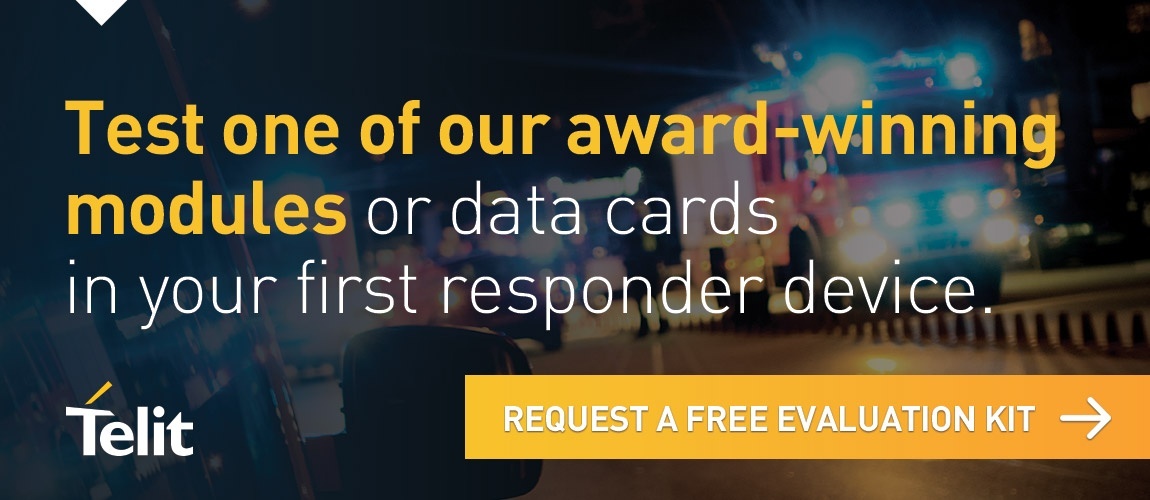How Advances in Gigabit LTE Are Improving Public Safety
By Ken Bednasz
November 29, 2018
When disaster strikes, mobilizing a network of first responders in a hurry saves countless lives. Natural disasters, fires and other emergency situations depend on operations grids to quickly provide supplies and resources to areas where public safety is at risk. Ultra-high-speed communication networks and Internet of Things (IoT) modules are helping first responders access information from a variety of sources, including cell phones, mobile devices, cameras, internet appliances and more.

New advancements with 4G LTE Cat 18 cellular broadband connectivity and IoT solutions help get information to first responders in critical areas where data transfer is either slow or (up to this point) inaccessible.
First responder device traffic has priority over non-emergency devices in Public Safety networks. For example, if there’s a hurricane or flash flood and first responders assemble to help, there is a massive amount of data that’s being exchanged and distributed. Responders often receive important data where out-of-range service and slow data transfer could severely impede response times and information delivery.
Speed matters when saving lives.
In 2015, the Department of Homeland Security Science and Technology Directorate (S&T) launched “the Incident Management Information Sharing (IMIS) pilot to harness the capabilities of Internet of Things (IoT) to improve first responders’ situational awareness during emergencies.” Through a network of sensors and modules, IoT will connect these devices to help users share locations, updates, alerts, descriptions, visuals, and more. Sensors connect the entire network at the moment of incident.
The speed at which data travels is only getting higher. For enterprise networks connecting first responders, 4G and 5G with Gigabit LTE cellular broadband speeds mean instantaneous metrics for life-saving operations.
The new advancement in 4G LTE connectivity with Cat 18 is critical for boosting these new network capabilities.
Cat 18 modules, like Telit’s LM960 PCI Express Mini Card (mPCIe) fulfil the need for urgent ultra-high-speed applications with up to 1.2 Gbps download and 150 Mbps upload. It also operates with full multi-GNSS support. Cat 18 technology is made possible by a number of technology factors like 265 QAM high order modulation, 5-wide carrier aggregation and 4×4 MIMO antenna tech which doubles spectral efficiency, increasing data throughput speeds in the real world, improving transmission quality while minimizing the risk of signal loss, dropped calls, and partial downloads.
By 2025, there will be an estimated 75.4 billion devices connected through IoT solutions. Smart cities, healthcare, transportation, sports stadiums, and virtually every part of our world will be equipped with the means to transfer information remotely.
Public Safety programs across the United States are already implementing high-speed first responder networks, dedicated to driving a “innovation and create a system of modern, life-saving devices, apps and tools for first responders.” IoT-driven first responder networks will modernize communications across EMS, fire, police, and volunteer organizations. For example, one program in Minnesota is working to expand network coverage through wilderness areas and around the state’s “many lakes and waterways.”
Innovations in first responder IoT solutions include everything from physiological monitors, vehicle geospatial position trackers, mobile video cameras, laser rangefinders, 3D visualization and tracking, gunshot detection, video analytics, video drones, supply deployment drones, and more. The DHS Science and Technology Directorate has been running drills and scenarios “developed to simulate an incident where fire, law enforcement, and emergency medical units would deploy, discover and integrate diverse sensors and platforms to gain situational awareness.”
The natural progression of IoT solutions and the capabilities of networks using 4G LTE Cat 18 will undoubtedly improve response times and save lives worldwide.
Improving public safety means equipping first responders with the right tools.
Telit, a global leader in IoT enablement, provides enterprise-grade hardware, connectivity, and platforms to connect and monitor millions of devices across the globe. Our mobile broadband connectivity modules delivers the highest available speeds that cellular networks can support. Along with the LM960 LTE Cat 18 data card, Telit provides a host of cellular broadband products for your gateways, routers, network appliances and cellular SD-WAN applications for commercial as well as public safety applications.
Is your first response network prepared? Contact us and find out which modules can boost your project’s performance today.
